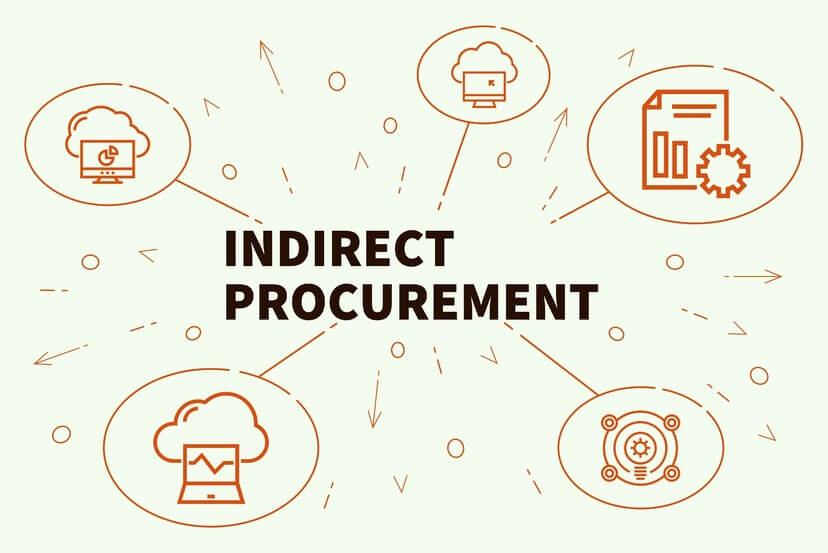5 Ways CPOs Can Leverage AI and Automation in Indirect Procurement

5 Ways CPOs Can Leverage AI and Automation in Indirect Procurement
In today’s rapidly evolving business landscape, Chief Procurement Officers (CPOs) face relentless pressure to optimize spending, enhance efficiency, and align procurement strategies with overarching organizational objectives.
Indirect procurement—covering essential non-production goods and services—is now a prime area for AI and automation to drive efficiency and cost savings.
This article explores five impactful ways AI and automation are reshaping indirect procurement and how CPOs can effectively leverage these innovations.
1. Enhancing Spend Visibility and Analysis
One of the biggest challenges in indirect procurement is gaining a clear understanding of spending patterns.
Often, these purchases are decentralized and lack centralized oversight, leading to maverick spending, duplicated efforts, and missed opportunities for cost consolidation.
AI-powered analytics consolidate data from multiple sources, offering CPOs a real-time, holistic view of indirect procurement spending.
These tools can identify spending trends, pinpoint areas of leakage, and highlight opportunities for negotiation and cost reduction.
By gaining granular visibility into their indirect spend, CPOs can make data-driven decisions and develop targeted strategies for optimization.
2. Automating Routine Procurement Tasks
Indirect procurement often involves a significant amount of manual, repetitive tasks, such as purchase order creation, invoice processing, and supplier onboarding.
Automation can streamline these processes, freeing up procurement professionals to focus on more strategic activities.
Robotic Process Automation (RPA) can automate rule-based tasks, reducing errors, accelerating cycle times, and lowering operational costs.
AI-powered chatbots can also handle routine inquiries and provide support to internal stakeholders, further enhancing efficiency.
By automating these routine tasks, CPOs can improve productivity, reduce administrative overhead, and improve the overall efficiency of the procurement function.
3. Optimizing Supplier Management
Handling multiple suppliers is time-intensive and often inefficient without AI-driven insights.
AI can help CPOs optimize supplier relationships by providing insights into supplier performance, risk, and compliance.
AI tools assess supplier risks—financial instability, regulatory compliance, or supply chain disruptions—helping CPOs make data-driven decisions.
They can also automate supplier performance reviews and provide recommendations for supplier selection and development.
By leveraging AI for supplier management, CPOs can reduce risk, improve supplier performance, and build stronger, more strategic partnerships.
4. Driving Cost Savings Through Smart Negotiations
Optimizing supplier contracts and pricing strategies is key to reducing indirect procurement costs.
AI can empower CPOs with data-driven insights to support their negotiations.
AI-powered tools can analyze historical pricing data, market trends, and supplier information to identify optimal pricing strategies.
They can also simulate different negotiation scenarios and provide recommendations for achieving the best possible outcomes.
By leveraging AI for negotiations, CPOs can drive significant cost savings and improve their bargaining position.
5. Enabling Strategic Sourcing
AI-driven strategic sourcing identifies the most cost-effective and high-quality suppliers based on market trends and performance data.
AI can play a crucial role in this process by analyzing market data, supplier capabilities, and internal requirements to identify potential suppliers that meet the organization’s needs.
AI-powered platforms can also automate the request for proposal (RFP) process, streamlining supplier selection and reducing the time and effort required for sourcing activities.
By leveraging AI for strategic sourcing, CPOs can identify the most qualified suppliers, negotiate favorable terms, and ensure that the organization is getting the best value for its money.
Case in Point: A Global Manufacturer’s AI Transformation
A global manufacturing company implemented an AI-powered procurement platform to transform its indirect procurement processes.
The AI platform seamlessly integrated with the company’s ERP, delivering real-time spend visibility and actionable cost-saving insights.
The AI-powered analytics tools identified significant opportunities for cost consolidation and contract renegotiation.
The company also automated its purchase order process, reducing processing time by 50%.
These initiatives led to a 15% drop in indirect procurement costs and a substantial boost in operational efficiency.
Conclusion: The Future of Indirect Procurement is Intelligent
AI and automation are reshaping indirect procurement—driving efficiency, lowering costs, and reducing supplier risks.
By embracing these technologies, procurement leaders can transition from being operational managers to strategic enablers, driving value across the organization.
The future of indirect procurement is intelligent, and CPOs who embrace AI and automation will be best positioned to succeed in the increasingly competitive global marketplace.
Ready to transform your procurement function with AI and automation?
Partner with us at Moglix to unlock the full potential of smart procurement solutions. Mail your inquiries to emea@moglixbusiness.com or contact us today to get started: https://business.moglix.ae/contact-us/
The Rise of Smart Indirect Procurement: How CPOs are Redefining Cost Management

The Rise of Smart Indirect Procurement: How CPOs are Redefining Cost Management
Direct procurement, focuses on raw materials and production components, and often receives significant attention. Indirect procurement, covering essential business operations, is a largely untapped area where CPOs can unlock major cost savings and efficiency improvements.
This is where the rise of smart indirect procurement comes into play, empowering CPOs to redefine cost management and drive strategic impact.
What is Smart Indirect Procurement?
Smart indirect procurement goes beyond traditional transactional purchasing.
It’s a strategic approach that leverages technology, data analytics, and collaborative partnerships to streamline processes, gain spend visibility, and optimize costs associated with non-production related goods and services.
It’s about moving from reactive purchasing to proactive, data-driven decision-making.
Why Indirect Procurement Matters?
Indirect procurement, while often overlooked, represents a significant portion of overall organizational spending.
Key indirect procurement areas like office supplies, IT, travel, marketing, and MRO contribute significantly to operational costs.
Inefficient management of these categories can lead to inflated prices, maverick spending, and lost opportunities for cost consolidation.
Smart indirect procurement addresses these challenges, enabling CPOs to gain control over this often-fragmented spending and unlock substantial savings.
How CPOs Are Redefining Cost Management in Indirect Procurement?
CPOs are leveraging several key strategies to transform indirect procurement and drive significant cost improvements:
- Harnessing Data for Spend Analysis: Visibility is the foundation of effective cost management.
CPOs are deploying advanced analytics and spend management software to gain a comprehensive view of spending patterns across all indirect categories.
These tools provide real-time insights into who is buying what, from whom, and at what price.
This granular data allows CPOs to identify opportunities for cost savings, eliminate redundant purchases, and negotiate better pricing with suppliers.
- Adopting Automation: Manual processes, such as invoice processing, purchase order generation, and supplier onboarding, are time-consuming, error-prone, and costly.
CPOs are automating these tasks using specialized procurement platforms and e-procurement solutions.
Automation not only reduces operational costs and frees up valuable time for procurement professionals to focus on strategic activities but also minimizes errors and accelerates procurement cycle times.
- Implementing Category Management: Category management is a strategic approach to organizing procurement activities around specific categories of spend.
CPOs are implementing category management strategies to consolidate spending within key areas, such as IT, office supplies, or travel.
By centralizing procurement for these categories, organizations can leverage their buying power to negotiate better pricing and contract terms with suppliers.
It also reduces the number of suppliers and standardizes product offerings.
- Focusing on Supplier Collaboration: Smart indirect procurement recognizes the importance of strong supplier relationships.
CPOs are moving beyond transactional interactions and building strategic partnerships with key suppliers.
Collaborative relationships foster innovation, improve service levels, and unlock opportunities for cost reduction through joint initiatives, such as value engineering and continuous improvement programs.
- Leveraging AI and Predictive Analytics: Artificial intelligence (AI) and predictive analytics are transforming indirect procurement by providing CPOs with powerful tools for forecasting demand, optimizing pricing, and managing risk.
AI-powered solutions can analyze historical data, market trends, and supplier information to predict future demand for indirect goods and services.
This allows CPOs to proactively negotiate contracts, avoid stockouts, and optimize inventory levels.
Predictive analytics can also help identify potential risks in the supply chain, allowing CPOs to take proactive measures to mitigate disruptions.
Key Benefits of Smart Indirect Procurement
The adoption of smart indirect procurement strategies delivers a range of significant benefits:
- Cost Savings: By gaining spend visibility, consolidating suppliers, and negotiating better pricing, CPOs can achieve significant cost reductions in indirect procurement.
- Operational Efficiency: Automation and streamlined processes improve procurement cycle times, reduce administrative overhead, and free up procurement staff to focus on strategic initiatives.
- Risk Mitigation: Predictive analytics and enhanced supplier collaboration help CPOs identify and mitigate potential risks in the supply chain, ensuring business continuity.
- Sustainability: Smart indirect procurement enables CPOs to integrate environmental, social, and governance (ESG) criteria into procurement decisions, driving sustainability goals and promoting responsible sourcing practices.
Conclusion: The Future of Indirect Procurement
Smart indirect procurement is no longer a futuristic concept; it’s a necessity for organizations seeking to optimize spending, improve efficiency, and drive strategic value.
By embracing data-driven decision-making, automation, and collaborative partnerships, CPOs are transforming indirect procurement from a tactical function to a strategic driver of business success.
Discover how smart indirect procurement can optimize your cost management strategy. Contact us at emea@moglixbusiness.com.
2025 Procurement Outlook: How Much Does PR-to-PO Digitization Matter to CPOs?

2025 Procurement Outlook: How Much Does PR-to-PO Digitization Matter to CPOs?
In today’s dynamic business environment, Chief Procurement Officers (CPOs) are constantly exploring strategies to enhance efficiency, lower costs, and foster innovation. One key development in this pursuit is PR-to-PO digitization, a transformation that moves procurement processes from paper-based, manual systems to automated, digital workflows. But why does this shift matter so much to CPOs? Let’s take a closer look.
What is PR-to-PO Digitization?
PR-to-PO digitization refers to the seamless integration of systems that connect Purchase Requisitions (PR) to Purchase Orders (PO). This process removes manual interventions by automating tasks like request creation, approval workflows, order placements, and supplier communications. It’s all about streamlining the procurement cycle, making it faster, more accurate, and more cost-effective.
Why PR-to-PO Digitization Matters?
1. Enhanced Process Efficiency
One of the most significant benefits of PR-to-PO digitization is improved efficiency. Traditional procurement workflows can be time-consuming and prone to errors. Automating routine tasks, like approvals and data entry, allows procurement teams to save significant time on repetitive processes. Automation allows for faster turnaround times, better resource allocation, and smoother operations. This is critical as organizations strive to stay competitive and responsive to changing market dynamics.
2. Improved Accuracy
Manual procurement processes often lead to human errors, such as incorrect data entry, delayed approvals, or mismatched orders. These mistakes can result in costly rework, delays, and strained supplier relationships. PR-to-PO digitization resolves these issues by enabling single-point data entry that is automatically propagated throughout the procurement cycle. With built-in checks and validation rules, digitization enhances data accuracy, minimizing the risk of mistakes and ensuring compliance with organizational standards.
3. Real-Time Visibility
With PR-to-PO digitization, CPOs gain real-time visibility into procurement activities. They can track purchase requisitions, approvals, and purchase orders at every step of the process, all in one centralized system. This enhanced visibility enables procurement teams to quickly identify bottlenecks, address delays, and ensure that orders are being processed as expected. Additionally, it enables CPOs to track supplier performance, promptly address issues, and ensure seamless procurement operations.
4. Cost Savings
Cost-saving is a top priority for CPOs, and PR-to-PO digitization plays a significant role in achieving this goal. By automating processes, reducing errors, and improving supplier collaboration, organizations can minimize costs associated with procurement. Digitization also allows for better contract management, price tracking, and order consolidation, which can lead to volume discounts and improved terms with suppliers. Over time, these efficiencies translate into substantial savings for the organization.
5. Better Supplier Relationships
Supplier relationships are crucial for procurement success, and PR-to-PO digitization helps improve communication and collaboration between buyers and suppliers. Digital systems can enable real-time updates, automatic notifications, and more transparent processes, leading to smoother transactions and fewer misunderstandings. Suppliers gain access to portals that enable order tracking, invoice management, and swift issue resolution. This fosters stronger, more reliable partnerships and creates opportunities for joint growth and innovation.
The Impact of PR-to-PO Digitization on CPOs
For CPOs, the digital transformation of procurement is not just about adopting new technology—it’s a strategic enabler that aligns with broader organizational goals. PR-to-PO digitization empowers CPOs to:
Drive Lean Procurement
Automating processes and eliminating inefficiencies make PR-to-PO digitization a cornerstone of lean procurement strategies. CPOs can streamline operations, reduce overhead costs, and focus on value-added activities. This alignment with lean principles helps procurement teams achieve operational excellence and ensures resources are utilized efficiently.
Enhance Decision-Making
Access to real-time data and analytics allows CPOs to make more informed and proactive decisions. They can quickly analyze procurement performance, identify trends, and make adjustments as needed. This agility is crucial in today’s fast-paced business environment, where quick decision-making can lead to a competitive advantage.
Lead Digital Transformation
PR-to-PO digitization positions procurement as a leader in digital transformation. Adopting advanced technologies enables CPOs to spark innovation across the procurement function and beyond. It shows that procurement is not just a support function but a strategic driver of change and modernization.
Looking Ahead to 2025
As organizations continue to embrace digital transformation, PR-to-PO digitization will remain a key priority for CPOs. Streamlining procurement, enhancing efficiency, and reducing costs empower CPOs to drive organizational growth and success well into 2025 and beyond. To gain deeper insights into the future of procurement, including lessons learned from 2024, explore our full whitepaper. For further inquiries, feel free to reach out to us at emea@moglixbusiness.com.
2025 Procurement Outlook: How Much Visibility Do CPOs Have into the Supply Chain?

2025 Procurement Outlook: How Much Visibility Do CPOs Have into the Supply Chain?
Supply chain visibility is essential in today’s interconnected world, where disruptions can significantly impact industries. For Chief Procurement Officers (CPOs), having a clear view of supply chain operations is not just a competitive advantage—it’s essential for reducing inefficiencies, protecting margins, and navigating uncertainty in global markets in 2025.
Unlocking Supply Chain Efficiency: The Need for a Holistic View
Supply chains are the backbone of global business. However, inefficiencies caused by a lack of transparency hinder decision-making and increase operational costs. To remain competitive in 2025, CPOs must adopt a comprehensive approach to gain end-to-end visibility and optimize their supply chains.
1. Asymmetry of Information: The Silent Disruptor
The fragmented flow of information between manufacturers, suppliers, and retailers creates significant inefficiencies. Without unified visibility, predicting demand patterns becomes difficult, often resulting in avoidable disruptions. Investing in digital platforms that connect all supply chain stakeholders in real-time can eliminate these gaps. With tools like cloud-based systems, businesses can achieve seamless communication and minimize disruptions caused by information asymmetry.
2. The Cost of Opacity: Slow Decision-Making
Opaque supply chains result in decisions made without a comprehensive understanding of key situations. This lack of clarity slows transactions, decreases business agility, and contributes to broader economic challenges, such as reduced productivity.
Advanced technologies, including real-time analytics and AI, can provide actionable insights that enhance decision-making speed, improve operational efficiency, and help businesses thrive in competitive markets.
3. Variability in the Upstream: The Bullwhip Effect
Small upstream disruptions often result in significant downstream effects.
Delays, cost overruns, and service level agreement (SLA) breaches are all consequences of this variability. By enhancing upstream visibility, CPOs can proactively address potential issues, stabilize supply chain operations, and maintain smooth downstream workflows.
4. Waste: The Hidden Cost of Invisibility
Without proper visibility, inefficiencies such as overstocking, understocking, and wasted resources become prevalent. This directly impacts operational costs and limits profitability. Using advanced technology to monitor inventory levels and supplier performance helps businesses reduce waste, control costs, and continuously improve supply chain operations.
5. Navigating the “Now” to Reach the “Next”
CPOs must understand the current state of their supply chain to plan for future growth and improvements. Visibility into existing operations allows for agile decision-making, cost optimization, and the flexibility to adapt to rapidly changing market conditions. By using predictive analytics and other data-driven technologies, organizations can transition from reactive to proactive strategies, ensuring sustained growth and resilience.
6. Margin Protection: The Key to Staying Competitive
Without real-time insights into supply chain activities, businesses struggle to manage costs and mitigate risks, leaving margins exposed. In an environment where margins are already under pressure, this lack of visibility can be detrimental. Implementing technologies that offer dynamic tracking and analytics helps organizations safeguard profitability, reduce risks, and maintain their competitive edge.
7. Process and Technology: The Dual Approach
To resolve supply chain visibility challenges, businesses need a dual approach. Streamlined processes improve efficiency, while advanced technologies such as AI, machine learning, and real-time analytics enable informed decision-making. This combination ensures higher ROI, increased efficiency, and long-term sustainability in supply chain management.
Conclusion
The future of supply chain visibility lies in adopting technology-driven solutions and robust processes. As CPOs plan for 2025, aligning operations with a long-term transparency strategy is critical to addressing challenges, safeguarding margins, and reducing costs.
For further insights and a comprehensive outlook for 2025, access our full whitepaper. Mail your inquiries to emea@moglixbusiness.com.
UAE’s Digital Procurement Platform is a Game Changer, Believe CPOs. Know Why

UAE’s Digital Procurement Platform is a Game Changer, Believe CPOs. Know Why
The UAE government has been considering the use of AI to solve real-world problems for the last decade, starting with the establishment of the UAE Council for Artificial Intelligence and Blockchain in 2018.
In 2021, the Ministry of Finance introduced the Digital Procurement Platform (DPP), bringing about a radical change in the procurement process by incorporating AI.
This transformative tool not only facilitates communication between federal procurement teams and suppliers but also empowers Chief Procurement Officers (CPOs) to streamline their procurement process. Currently, the platform is being expanded to include a wider range of product categories and offerings.
At present, the extensive catalog consists of 35 categories, offering access to over 120,000 services and products sourced from 230 pre-approved suppliers
According to the Ministry of Finance, the platform has yielded significant benefits over the last couple of years. The entire procurement process is digital and simple, cutting down the steps involved from 11 to just 3.
This massive reduction slashes the purchase cycle time by 75%. Such efficiency doesn’t just benefit the government but sets a powerful example for the corporate sector in the UAE. With these changes, a new “fit-for-purpose data” framework is emerging, influencing how businesses will approach procurement in the future.
5 Key Digital Shifts in Procurement
1. Contract Drafting
As per a recent study of 400 procurement leaders by KPMG, 50% to 80% of procurement work is so repetitive that it can be automated, eliminated or shifted to self-service models.
Through the adoption of generative AI, CPOs can ensure contract drafting is faster, more accurate, and significantly less labor-intensive.
It can automate the creation of contracts tailored to specific procurement needs, saving time and ensuring all legal requirements are met with minimal human intervention.
2. Contract Reporting & Analytics
Going digital requires data generation, but data generation alone is insufficient. The goal is to analyze and transform such data to make more informed judgments and improve procurement methods.
We believe predictive AI will play a key role in this shift. Predictive AI working in tandem with prompt engineers, can provide important insights on category and sourcing strategies, process improvement ideas, and supplier development plans.
It could have the power to analyze previous procurement data to forecast patterns, detect potential dangers, and highlight prospects for cost savings.
This will help CPOs better understand the expenses connected with the procurement activities they are currently performing.
3. Contract Editing
Today, whether you’re sending an email or text message, or searching on your favorite search engine, you get real-time suggestions.
These suggestions are developed using a combination of data analysis, machine learning, and computational algorithms, with the goal of providing the most appropriate suggestion for each case.
Contract editing could be made easier, less labor intensive and cost efficient by integrating prescriptive AI into your procurement process, allowing for contracts that are precise, compliant, and in line with corporate objectives.
Prescriptive AI can automatically analyze contracts for errors, inconsistencies, and potential risks. It can highlight clauses that may need revision or further clarification based on predefined rules and best practices.
4. Invoice to Pay
Another large impact area for Generative AI will be revolutionizing the invoice-to-pay process. The accuracy of invoice classification and cash flow prediction is significantly enhanced by AI systems.
We believe through a combination of generative and predictive AI, detecting and preventing fraud, utilizing powerful anomaly detection algorithms could be inherent. Additionally, seamless integration with legacy invoice management systems could ensure easy acceptance and adoption.
Use of digital technologies can transform the invoice to payment process into a more efficient, secure, and strategically valuable element of procurement operations.
5. Supplier Relationship Management
The above-mentioned KPMG study highlights that supplier relationship management remains a critical area for all CPOs. The study identifies three primary challenges: acquiring essential performance data, strategically managing key suppliers, and addressing inefficient management processes.
With Generative AI, CPOs can tackle these challenges by automating data collection. It will be able to integrate data from different internal systems, monitor changes in delivery performance, quality, and lead times.
It can also provide autonomous scorecard evaluations for a select group of suppliers. A combination of Generative, Predictive, and Prescriptive AI will enhance supplier interactions by providing analysis and recommending areas for mutual performance enhancement.
Future of Digital Procurement
With Stage 3 of UAE’s Digital Procurement Platform implemented, it’s no more step forward—it’s a leap. A progressive change such as this, in government-to-business (G2B) procurement will inevitably influence business-to-business (B2B) interactions over the next decade.
Companies like Moglix, for almost a decade, are leading the charge on digital transformation not just in India but also in the UAE, helping organizations in the UAE stay ahead in their digital procurement journey, with its most comprehensive procurement solution.
Moglix’s Integrated Procurement البرمدة كخدمة Solution, Automated Workflows, and Catalog-Based Buying Solutions, combines with its state-of-the-art physical warehouse network to revolutionize your business’s approach to procurement.

